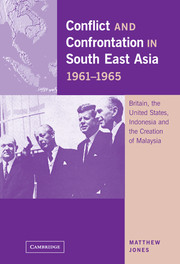 Conflict and Confrontation in South East Asia, 1961–1965
Conflict and Confrontation in South East Asia, 1961–1965 Book contents
- Frontmatter
- Contents
- List of maps
- Preface and acknowledgements
- List of abbreviations
- South East Asia
- Indonesia and Malaysia
- Introduction: Britain, the United States and the South East Asian setting
- Part I Build-up
- Part II Outbreak
- 5 The emergence of confrontation: January–May 1963
- 6 The path to the Manila summit, May–July 1963
- 7 From the Manila summit to the creation of Malaysia: August–September 1963
- 8 Avoiding escalation, September–December 1963
- Part III Denouement
- Conclusion: The Western presence in South East Asia by the 1960s
- Bibliography
- Index
8 - Avoiding escalation, September–December 1963
Published online by Cambridge University Press: 25 July 2009
- Frontmatter
- Contents
- List of maps
- Preface and acknowledgements
- List of abbreviations
- South East Asia
- Indonesia and Malaysia
- Introduction: Britain, the United States and the South East Asian setting
- Part I Build-up
- Part II Outbreak
- 5 The emergence of confrontation: January–May 1963
- 6 The path to the Manila summit, May–July 1963
- 7 From the Manila summit to the creation of Malaysia: August–September 1963
- 8 Avoiding escalation, September–December 1963
- Part III Denouement
- Conclusion: The Western presence in South East Asia by the 1960s
- Bibliography
- Index
Summary
During the course of 1963, the Communist insurgency in South Vietnam had made striking gains, prompting alarm in the Kennedy Administration that the commitment of additional resources that had been made to the Diem regime in late 1961 would not be sufficient to avert a collapse of the entire position. In September, the President conducted interviews for television news that emphasized his belief in the domino theory, the threat to South East Asia from Communist China, and his opposition to any early withdrawal of US personnel from Vietnam. However, at the same time, he was also indicating disapproval for the current policies of the government in Saigon, and underlining the fact that the war was essentially one for the Vietnamese themselves to fight. With 16,000 US advisers already working within South Vietnam, however, pressures were beginning to mount for a further escalation of American effort. It seemed likely that several critical decisions would have to be taken soon over the future level of commitment, and with an election due in November 1964, the domestic political calculations of the Administration were by no means clear-cut. There was evidently much to be said for doing everything to avoid any further disturbances off mainland South East Asia, where any instance of overt Indonesian aggression could present fresh dilemmas as to how the United States would respond.
- Type
- Chapter
- Information
- Conflict and Confrontation in South East Asia, 1961–1965Britain, the United States, Indonesia and the Creation of Malaysia, pp. 205 - 232Publisher: Cambridge University PressPrint publication year: 2001


